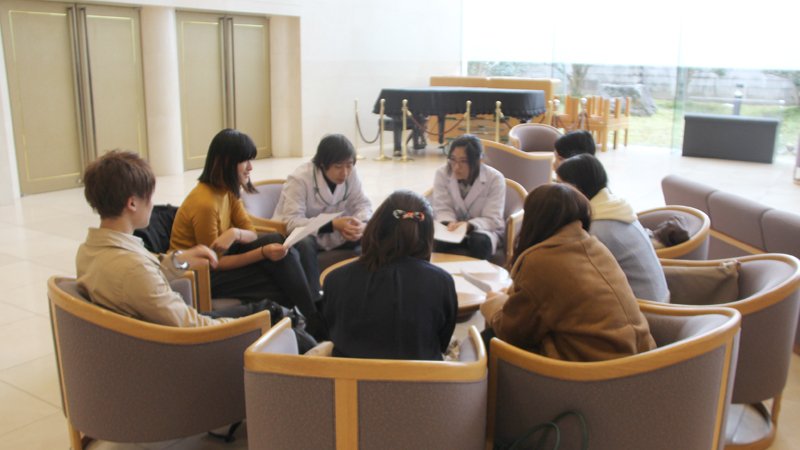I had the opportunity this semester work Kyoto National Museum to fulfill my CIP requirement. As my focus within my East Asian Languages and Cultures program is art history, this was a dream come true. I would get to work not only with the objects I had spent countless hours looking at in books and behind plexiglass cases, but at the same time I would get to use my Japanese in a professional environment. This kind of opportunity, though, naturally came with a lot of pressure: as I hope to enter museum work eventually as a professional, my coworkers and bosses weren’t just people I would be working with for the semester, but people I’d be in contact with for the rest of my career.
The CIP isn’t just an opportunity to apply Japanese in real life, but also to engage in real-time cultural learning. For me, this started right away. My entry into the museum in the capacity of volunteer research assistant and translator was a bit unprecedented—all kinds of people volunteer at the Museum, and many art history graduate students help with research and curatorial initiatives, but as an undergraduate in a non-Japanese degree program, I was not the most obvious candidate to help out the curatorial board. A lot of negotiating had to be done to get me in, and so on my arrival, my acquaintance at the Museum then helped me do the jikoshoukai and thank to the appropriate people—except that the appropriate people meant everyone who worked in the curatorial office. This surprised me; the idea of the jikoshoukai certainly doesn’t have an exact counterpart in English-language cultures, but the formality of the self-introduction aside, you would certainly never introduce yourself to so many people at the same time in an American office. I nervously moushimasu’d and yoroshiku onegaiitashimasu’d so many times on the first day that by the end I could hardly say the words correctly any more. This was my first indication that in the Japanese office environment, no matter how compartmentalized individual tasks may be, the whole office has significant input and participation in pretty much every aspect of operations, and because of that everyone is expected to be able to interact with everyone else from the get-go.
I hit the ground running: there was much to be translated. I was allowed to work on a variety of projects, starting with object labels from the Museum’s permanent collection which were out on frequent rotation, progressing through the special Hinamatsuri exhibition, instructional and didactic sheets for upcoming family workshops, and ultimately editing the audioguide script and translating articles for the monthly KNM newsletter and labels for the special Kaiho Yusho exhibition. I also learned the layout of the museum, and got to assist in a special showing of the Yamai no Soushi for visiting scholars. Such diverse projects exposed me to so many different aspects of the office culture. Of course, as a museum is a bit of a unique shokuba, I can’t imagine that this sort of office culture is applicable everywhere, but it felt great to begin to get a handle on what it feels like to be a member of Japanese working society.
The most interesting thing about the experience, in terms of cultural learning, was the snacks. At various jobs and internships I’ve held in the US, there’s usually a kitchen somewhere, with a pot of stale coffee on the counter and someone’s leftovers in the refrigerator. However, this was not the case here whatsoever. My desk, part of the education department’s section, sat right across from the designated snack table. Edible meibutsu are a big part of Japanese omiyage and otherwise gift-giving culture; whenever somebody would come from outside the museum for any sort of business meeting or special viewing, some sort of fancily wrapped okashi would undoubtedly accompany them, regardless of their relation to the museum. After being humbly accepted, the snacks would then be passed around to the people who had the most direct relation to the meeting or showing, then be set out on the snack table for anyone to enjoy. Museum staff who went on vacation or business trips would similarly bring back snacks for the office, distributed in a similar fashion.
I had a discussion with one of the curators about this snacking culture. I expressed the genuine surprise I had felt when I received my first wagashi, a manju from Tokyo given by a visiting scholar, after helping with an object showing. She laughed and asked if this sort of gift giving was not standard in America—my response couldn’t have been a vehement enough “no.” If this happened to anyone in a professional environment in the US (myself included) I would be immediately be suspicious that the person giving the gifts wanted some sort of favor for me. As “yoroshiku onegaishimasu” implies, this sort of gift giving in Japan does presume to elicit a favor in a vague sense—that of continued good relations—but not in the way I’d infer in an English-speaking environment.
The learning experiences, both academic and cultural, afforded to me at the Museum have been invaluable, and they are memories of satisfying work and enjoyable conversation that I will cherish for a long time. To anyone considering this sort of formal work environment for their own CIP, I can only advise to not hesitate and to jump in straightaway. Initially, because of the perceived culture and language barrier, it can be a bit difficult to prove your own merit, but once you situate yourself, the dedication to work is inspiring, and it’s a great feeling to be included in such dedicated pursuits.

